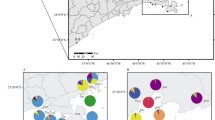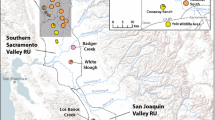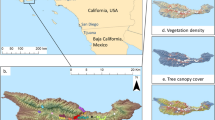Abstract
Wolves in the Canadian Arctic Archipelago face several challenges to persistence: a harsh habitat, an unstable prey base, and potentially significant anthropogenic influences. These external factors, if combined with genetic constraints common to island populations, could be particularly difficult to withstand. To determine the genetic status of Arctic Island wolves, we used 14 microsatellite loci to estimate population variation and the extent of inter-island and island-mainland gene flow. All island populations were significantly less variable than mainland wolves; although inbreeding is currently insignificant, the two least variable populations, Banks and the High Arctic (Ellesmere and Devon Islands), showed genetic signatures of recent population declines. Recovery after a bottleneck appears to result, in large part, via recolonization from other islands. These extinction-recolonization dynamics, and the degree of similarity among island wolves revealed by Bayesian clustering, suggest that Arctic Island wolves function as a metapopulation. Persistence of the metapopulation may be supported by periodic migration from mainland populations, occurring primarily through two corridors: Baffin Island in the Eastern Arctic, and Victoria Island in the Western Arctic. This gene flow could be compromised or eliminated by loss—due to climatic warming or increased human activity—of sea ice in the Northwest Passage.




Similar content being viewed by others
References
Barnes I, Matheus P, Shapiro B, Jensen D, Cooper A (2002) Dynamics of Pleistocene population extinctions in Beringian brown bears. Science 295:2267–2270
Bennike O, Andreasen C (2005) New dates of musk-ox (Ovibos moschatus) remains from northwest Greenland. Polar Rec 41:125–129
Carmichael LE, Nagy JA, Larter NC, Strobeck C (2001) Prey specialization may influence patterns of gene flow in wolves of the Canadian Northwest. Mol Ecol 10:2787–2798
Carmichael LE, Krizan J, Nagy JA, Fuglei E, Dumond M, Johnson D, Veitch A, Berteaux D, Strobeck C (2007) Historical and ecological determinants of genetic structure in arctic canids. Mol Ecol. doi:10.1111/j.1365-294X.2007.03381.x
Castric V, Bernatchez L (2004) Individual assignment test reveals differential restriction to dispersal between two salmonids despite no increase of genetic differences with distance. Mol Ecol 13:1299–1312
Charron A (2005) The Northwest passage—is Canada’s sovereignty floating away? Int J 60:831–848
Clark KRF (1971) Food habits and behavior of the tundra wolf on central Baffin Island. Ph.D. Dissertation, University of Toronto
di Rienzo A, Peterson AC, Garza JC et al (1994) Mutational processes of simple sequence repeat loci in human populations. Proc Natl Acad Sci USA 91:3166–3170
Elmhagen B, Angerbjorn A (2001) The applicability of metapopulation theory to large mammals. Oikos 94:89–100
England J (1999) Coalescent Greenland and Innuitian ice during the last glacial maximum: revising the Quaternary of the Canadian High Arctic. Quat Sci Rev 18:421–456
England J, Atkinson N, Bednarski J, Dyke AS, Hodgson DA, Cofaigh CÓ (2006) The Innuitian ice sheet: configuration, dynamics, and chronology. Quat Sci Rev 25:689–703
Environment Canada (2000) Canadian Climate Normal Data. Government of Canada. http://www.climate.weatheroffice.ec.gc.ca/climate_normals/index_e.html. Cited July 2006
Fedorov VB, Stenseth NC (2002) Multiple glacial refugia in the North American Arctic: inference from phylogeography of the collared lemming (Dicrostonyx groenlandicus). Proc R Soc Lond B 269:2071–2077
Felsenstein J (1985) Confidence limits on phylogenies: an approach using the bootstrap. Evolution 39:783–791
Felsenstein J (1995) PHYLIP (Phylogeny Inference Package), Seattle
Ferguson M (1989) Baffin Island. In: Hall E (ed) People and Caribou in the Northwest Territories. Department of Renewable Resources, Government of the Northwest Territories, Yellowknife, pp. 141
Frankham R (2005) Genetics and extinction. Biol Conserv 126:131–140
Fredholm M, Wintero AK (1995) Variation of short tandem repeats within and between species belonging to the Canidae family. Mamm Genome 6:11–18
Garza JC, Williamson EG (2001) Detection of reduction in population size using data from microsatellite loci. Mol Ecol 10:305–318
Gravlund P, Meldgaard M, Paabo S, Arctander P (1998) Polyphyletic origin of the small-bodied, high-arctic subspecies of tundra reindeer (Rangifer tarandus). Mol Phylogenet Evol 10:151–159
Guillot G, Estoup A, Mortier F, Cosso JF (2005) A spatial statistical model for landscape genetics. Genetics 170:1261–1280
Gunn A, Shank C, McLean B (1991) The history, status and management of muskoxen on Banks Island. Arctic 44:188–195
Hewitt GM (1996) Some genetic consequences of ice ages, and their role in divergence and speciation. Biol J Linn Soc 58:247–276
Johnston DM (2002) The Northwest Passage revisited. Ocean Dev Int Law 33:145–164
Kennedy LJ, Angles JM, Barnes A, Carmichael LE, Radford AD, Ollier WER, Happ GM (2007) DLA-DRB1, DQA1, and DQB1 alleles and haplotypes in North American gray wolves. J Hered. doi:10.1093/jhered/esm051
Kimura M, Crow JF (1964) The number of alleles that can be maintained in a finite population. Genetics 49:725–738
Krizan J (2005) Nunavut wolf morphology and diet study. Department of Environment, Nunavut Wildlife Management Division, Government of Nunavut, Iqualuit, p 59
Kurtén B, Anderson E (1980) Pleistocene mammals of North America. Columbia University Press, New York
Larter NC, Nagy JA (2000) Calf production and overwinter survival estimates for Peary caribou, Rangifer tarandus pearyi, on Banks Island, Northwest Territories. Can Field Nat 114:661–670
Larter NC, Nagy JA (2001a) Calf production, calf survival, and recruitment of muskoxen on Banks Island during a period of changing population density from 1986–1999. Arctic 54:394–406
Larter NC, Nagy JA (2001b) Variation between snow conditions at Peary caribou and muskox feeding sites and elsewhere in foraging habitats on Banks Island in the Canadian High Arctic. Arct Antarct Alp Res 33:123–130
Lamoureux SF, England J (2000) Late Wisconsinan glaciation of the central sector of the Canadian High Arctic. Quatern Res 54:182–188
Leonard JA, Vila C, Wayne RK (2005) Legacy lost: genetic variability and population size of extirpated US grey wolves (Canis lupus). Mol Ecol 14:9–17
MacPhee RDE, Tikhonov AN, Mol D, Greenwood AD (2005) Late quaternary loss of genetic diversity in muskox (Ovibos). BMC Evol Biol 5:49
Manning TH, Macpherson AH (1958) The mammals of Banks Island. Arctic Institute of North America, Montreal
McEwen EH (1955) A biological survey of the west coast of Banks Island. Canadian Wildlife Service, Ottawa
Mech LD (2005) Decline and recovery of a high Arctic wolf-prey system. Arctic 58:305–307
Mech LD, Boitani L (2003) Wolf social ecology. In: Mech LD, Boitani L (eds) Wolves: behavior, ecology, and conservation. University of Chicago Press, Chicago, p 1
Mellersh CS, Langston AA, Acland GM, Fleming MA, Ray K, Weigland NA, Francisco LV, Gibbs M, Aguirre GD, Ostrander EA (1997) A linkage map of the canine genome. Genomics 46:326–336
Miller FL (1995) Status of wolves on the Canadian Arctic Islands. In: Carbyn LN, Fritts SH, Seip DR (eds) Ecology and conservation of wolves in a changing world. Canadian Circumpolar Institute, Edmonton, p 35
Miller FL, Reintjes FD (1995) Wolf sightings on the Canadian Arctic Islands. Arctic 48:313–323
Nei M (1972) Genetic distance between populations. Am Nat 106:283–292
Nei M, Roychoudhury AK (1974) Sampling variances of heterozygosity and genetic distance. Genetics 76:379–390
Nowak RM (1995) Another look at wolf taxonomy. In: Carbyn LN, Fritts SH, Seip RD (eds) Ecology and conservation of wolves in a changing world. Canadian Circumpolar Institute, Edmonton, p 375
Nowak RM (2003) Wolf evolution and taxonomy. In: Mech LD, Boitani L (eds) Wolves: behavior, ecology, and conservation. University of Chicago Press, Chicago, p 239
Ostrander EA, Sprague GF, Rine J (1993) Identification and characterization of dinucleotide repeat (CA)n markers for genetic mapping in dog. Genomics 16:207–213
Paetkau D, Calvert W, Stirling I, Strobeck C (1995) Microsatellite analysis of population structure in Canadian polar bears. Mol Ecol 4:347–354
Paetkau D, Waits LP, Clarkson PL, Craighead L, Strobeck C (1997) An empirical evaluation of genetic distance statistics using microsatellite data from bear (Ursidae) populations. Genetics 147:1943–1957
Park SDE (2001) Trypanotolerance in West African cattle and the population genetic effect of selection. Ph.D. Dissertation, University of Dublin
Petit RJ, El Mousadik A, Pons O (1998) Identifying populations for conservation on the basis of genetic markers. Conserv Biol 12:844–855
Piry S, Luikart G, Cornuet JM (1999) BOTTLENECK: a computer program for detecting recent reductions in the effective population size using allele frequency data. J Hered 90:502–503
Pratchett T, Stewart I, Cohen J (2002) The science of Discworld, 2nd edn. Ebury Press, London
Pritchard JK, Stephens M, Donnelly P (2000) Inference of population structure using multilocus genotype data. Genetics 155:945–959
Ripple WJ, Larsen EJ (2000) Historic aspen recruitment, elk, and wolves in northern Yellowstone National Park, USA. Biol Conserv 95:361–370
Saitou N, Nei M (1987) The neighbor-joining method: a new method for reconstructing phylogenetic trees. Mol Biol Evol 4:406–425
Sokal RR, Rohlf FJ (1995) Biometry: the principles and practice of statistics in biological research, 3rd edn. W. H. Freeman and Company, New York
Spencer CC, Neigel JE, Leberg PL (2000) Experimental evaluation of the usefulness of microsatellite DNA for detecting demographic bottlenecks. Mol Ecol 9:1517–1528
Stewart TG, England J (1986) An early Holocene caribou antler from northern Ellesmere Island, Canadian Arctic Archipelago. Boreas 15:25–31
Titterington DM, Murray GD, Murray LS et al (1981) Comparison of discrimination techniques applied to a complex data set of head injured patients. J Roy Stat Soc A Sta 144:145–175
Usher PJ (1965) Banks Island: an area economic survey. Industrial Division, Department of Northern Affairs and National Resources, Ottawa
Van Zyll de Jong CG, Carbyn LN (1999) COSEWIC status report on the grey wolf (Canis lupus) in Canada. COSEWIC, Ottawa
Vilà C, Amorim R, Leonard JA et al (1999) Mitochondrial DNA phylogeography and population history of the grey wolf Canis lupus. Mol Ecol 8:2089–2103
Waltari E, Demboski JR, Klein DR, Cook JA (2004) A molecular perspective on the historical biogeography of the northern high latitudes. J Mammal 85:591–600
Walton LR, Cluff HD, Paquet PC, Ramsay MA (2001) Movement patterns of barren-ground wolves in the central Canadian Arctic. J Mammal 82:867–876
Weckworth BV, Talbot S, Sage GK, Person DK, Cook J (2005) A signal for independent coastal and continental histories among North American wolves. Mol Ecol 14:917–931
Wilson GA, Rannala B (2003) Bayesian inference of recent migration rates using multilocus genotypes. Genetics 163:1177–1191
Wolfe AP, King RH (1999) A paleolimnological constraint to the extent of the last glaciation on northern Devon Island, Canadian High Arctic. Quat Sci Rev 18:1563–1568
Acknowledgements
Thanks to all those who contributed samples or facilitated their collection: Alaska Raw Fur; D. Bewick and North American Fur Auctions; G. Jarrell at the University of Alaska Museum; P. Merchant; P. Clarkson; R. Otto; G. Bihun; D. Berezanski; R. Brenneman; and the numerous Hunters and Trapper’s Associations and wildlife officers across Manitoba, the Northwest Territories and Nunavut. Thanks to G. A. Wilson for updates to his program bayesass, assistance with interpretation of results, and helpful comments on the manuscript. We also appreciate the comments of S. Moore, R. K. Wayne, D. Coltman, D. Hik, and two anonymous referees on earlier drafts of the paper. Financial support was provided by the Natural Sciences and Engineering Research Council of Canada, the Alberta Ingenuity Fund, the Government of Nunavut, and the Northern Scientific Training Program.
Author information
Authors and Affiliations
Corresponding author
Electronic supplementary material
Below is the link to the electronic supplementary material.
Rights and permissions
About this article
Cite this article
Carmichael, L.E., Krizan, J., Nagy, J.A. et al. Northwest passages: conservation genetics of Arctic Island wolves. Conserv Genet 9, 879–892 (2008). https://doi.org/10.1007/s10592-007-9413-0
Received:
Accepted:
Published:
Issue Date:
DOI: https://doi.org/10.1007/s10592-007-9413-0




